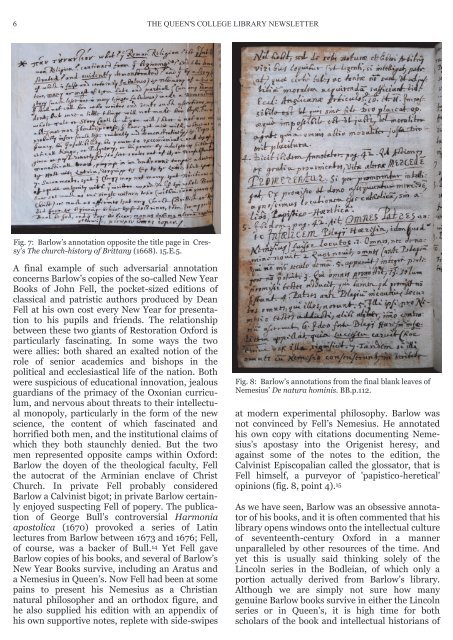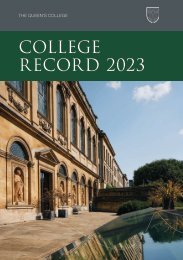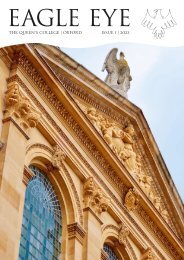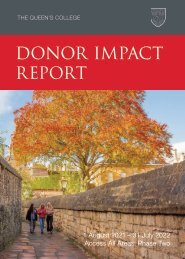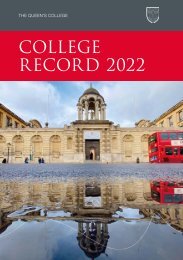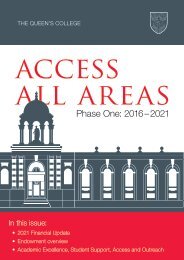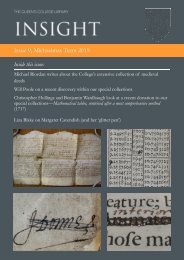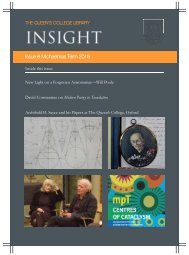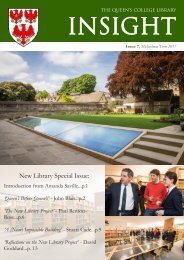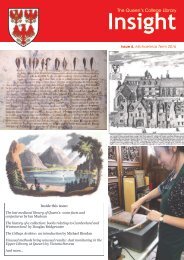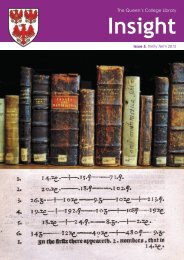Create successful ePaper yourself
Turn your PDF publications into a flip-book with our unique Google optimized e-Paper software.
6<br />
THE QUEEN'S COLLEGE LIBRARY NEWSLETTER<br />
Fig. 7: Barlow’s annotation opposite the title page in Cressy’s<br />
The church-history of Brittany (1668). 15.E.5.<br />
A final example of such adversarial annotation<br />
concerns Barlow’s copies of the so-called New Year<br />
Books of John Fell, the pocket-sized editions of<br />
classical and patristic authors produced by Dean<br />
Fell at his own cost every New Year for presentation<br />
to his pupils and friends. The relationship<br />
between these two giants of Restoration Oxford is<br />
particularly fascinating. In some ways the two<br />
were allies: both shared an exalted notion of the<br />
role of senior academics and bishops in the<br />
political and ecclesiastical life of the nation. Both<br />
were suspicious of educational innovation, jealous<br />
guardians of the primacy of the Oxonian curriculum,<br />
and nervous about threats to their intellectual<br />
monopoly, particularly in the form of the new<br />
science, the content of which fascinated and<br />
horrified both men, and the institutional claims of<br />
which they both staunchly denied. But the two<br />
men represented opposite camps within Oxford:<br />
Barlow the doyen of the theological faculty, Fell<br />
the autocrat of the Arminian enclave of Christ<br />
Church. In private Fell probably considered<br />
Barlow a Calvinist bigot; in private Barlow certainly<br />
enjoyed suspecting Fell of popery. The publication<br />
of George Bull’s controversial Harmonia<br />
apostolica (1670) provoked a series of Latin<br />
lectures from Barlow between 1673 and 1676; Fell,<br />
of course, was a backer of Bull. 14 Yet Fell gave<br />
Barlow copies of his books, and several of Barlow’s<br />
New Year Books survive, including an Aratus and<br />
a Nemesius in Queen’s. Now Fell had been at some<br />
pains to present his Nemesius as a Christian<br />
natural philosopher and an orthodox figure, and<br />
he also supplied his edition with an appendix of<br />
his own supportive notes, replete with side-swipes<br />
Fig. 8: Barlow’s annotations from the final blank leaves of<br />
Nemesius’ De natura hominis. BB.p.112.<br />
at modern experimental philosophy. Barlow was<br />
not convinced by Fell’s Nemesius. He annotated<br />
his own copy with citations documenting Nemesius’s<br />
apostasy into the Origenist heresy, and<br />
against some of the notes to the edition, the<br />
Calvinist Episcopalian called the glossator, that is<br />
Fell himself, a purveyor of 'papistico-heretical'<br />
opinions (fig. 8, point 4). 15<br />
As we have seen, Barlow was an obsessive annotator<br />
of his books, and it is often commented that his<br />
library opens windows onto the intellectual culture<br />
of seventeenth-century Oxford in a manner<br />
unparalleled by other resources of the time. And<br />
yet this is usually said thinking solely of the<br />
Lincoln series in the Bodleian, of which only a<br />
portion actually derived from Barlow’s library.<br />
Although we are simply not sure how many<br />
genuine Barlow books survive in either the Lincoln<br />
series or in Queen’s, it is high time for both<br />
scholars of the book and intellectual historians of


